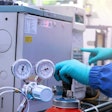
The stereotypical image of a sleep-deprived postdoc, in the lab late at night, conducting experiments while simultaneously scribbling in a lab notebook, may one day be a thing of the past. Our phones, watches, cars, and even houses have all become smarter over the past decade, and new software features are now also enabling laboratories to upgrade their IQs.
Laboratory information management systems (LIMS) are software packages designed to streamline workflow and manage information in the laboratory, with an eye toward regulatory compliance and simplifying lab management. Although the market for LIMS and other management software applications has been mature for several years now, new functionality such as increased integration and connectivity, along with increasing end-user adoption, is enabling disruptive changes to the business of lab management.
Approximately 43% of all labs globally use a LIMS, a percentage that is expected to grow in both the short and long term, according to a new report by Strategic Directions International (SDi) on the market for laboratory software, LIMS, chromatography data systems (CDS), mass spectrometry software (MSS), and other informatics products. Surveys suggest that among labs not using a LIMS now, 44% are considering a transition within the next two years.
 It's estimated that 43% of labs worldwide currently use a LIMS. Among labs that do not use a LIMS, an estimated 44% plan to use one within the next two years. Charts courtesy of Ryan Harake and SDi.
It's estimated that 43% of labs worldwide currently use a LIMS. Among labs that do not use a LIMS, an estimated 44% plan to use one within the next two years. Charts courtesy of Ryan Harake and SDi.Increased user friendliness has been a significant driver in converting and retaining end-user adoption of LIMS. For lab personnel and management to trust their lab data and information with a new digital platform, they must feel comfortable using and controlling the system via its user interface. Furthermore, for LIMS adoption to be successful, all users in a lab must become proficient in the software's operation and use -- otherwise, the system will lose its intended purpose as being the central hub for all of the lab's digital information.
Lack of standardization for lab instruments
A second critical driver of LIMS end-user adoption will be the availability of systems that have superior integration and connectivity with third-party software and instrumentation. In contrast to the USB innovation, which allowed personal computers to connect to accessory hardware such as printers and monitors, lab instruments suffer from a lack of standardization due to the vast types of connections and data file types currently used by different vendors.
A LIMS with the versatility and flexibility to connect, read, store, and share data between instruments and software systems is of great value to labs. Additionally, cloud-based servers and mobile device connectivity are two more features you will more frequently see integrated into next-generation LIMS platforms.
The ability to monitor the status of lab experiments and instruments remotely is of great value to lab managers looking to increase efficiency and quality while also reducing costs associated with frequent onsite visits. For example, future LIMS will be able to alert lab managers by phone in real-time when experimental parameters fall outside of a specified range, thereby saving resources by stopping the faulty experiment before completion.
While it may still be too soon for lab personnel to trade in their white coats, pipettes, and cell lines for beach chairs and umbrellas, the future of lab management is definitely becoming more hands-off due to many advances in LIMS software.
For a complete report on the market and end-user perspectives for LIMS and other lab software, see SDi's "2019 Market for Laboratory Software LIMS, CDS, MSS and Other Informatics."
Ryan Harake is a market analyst at SDi, a sister company of LabPulse.com.



















